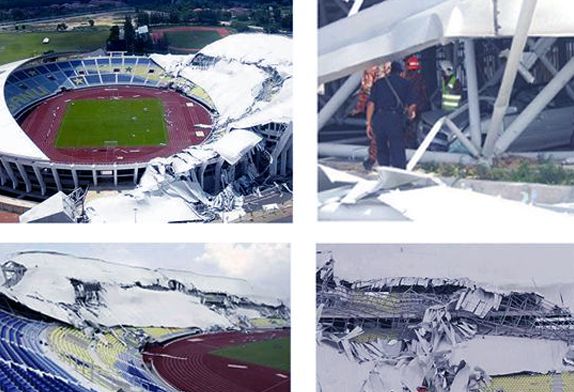 It was reported in June 2009, in Kuala Terrengganu, Malaysia, that the roof of a RM300 mil (US $90 mil) Sports Stadium collapses suddenly just after it was recently completed.
It was reported in June 2009, in Kuala Terrengganu, Malaysia, that the roof of a RM300 mil (US $90 mil) Sports Stadium collapses suddenly just after it was recently completed.
No one was injured, the damage was extensive, as practically the whole east wing came crush down at 8am in the morning, a few cars were damaged. The contractor was a South Korean Company, while the Consultants were local Malaysians. The Repairs were carried out and costs about RM35mil (US$10mil).
Since the works were still within the defects liability period which is usually 12 months or more for such a massive project, the cost of remedial works were borne by the Contractor. What other issues involved would be under the relevant authorities.
An Investigation Committee was immediately set up with involvement from the Public Works Department, Ministry of Works, Related Agencies, Experts, and an extensive report was later compiled.
Some of the photographs of the roof stadium collapse would be revealing:
The Reports by the Investigation Committee highlighted a few factors which could have contributed to the failure of the roof structures as summarized below:
- The design was inadequate
- The roof was not erected properly resulting in misalignment
- No quality control on Site
- Materials and Workmanship not in accordance to specifications
- Alternative designs from Contractor was adopted without proper analysis
The above sounds too familiar and so common in our construction industry. Almost every site is faced with these issues. In fact, space frame structures are very resilient and would not have been catastrophic in collapse, even if under designed. The concept of limit state design takes account of this, allowing collapse to be progressive rather than catastrophic. Only steel framed structures which does not combined the structural design with installation design are more prone to collapse, especially during erection period, and particularly for 3D space frame structures.











 About Us
About Us 2021-04-13
2021-04-13


